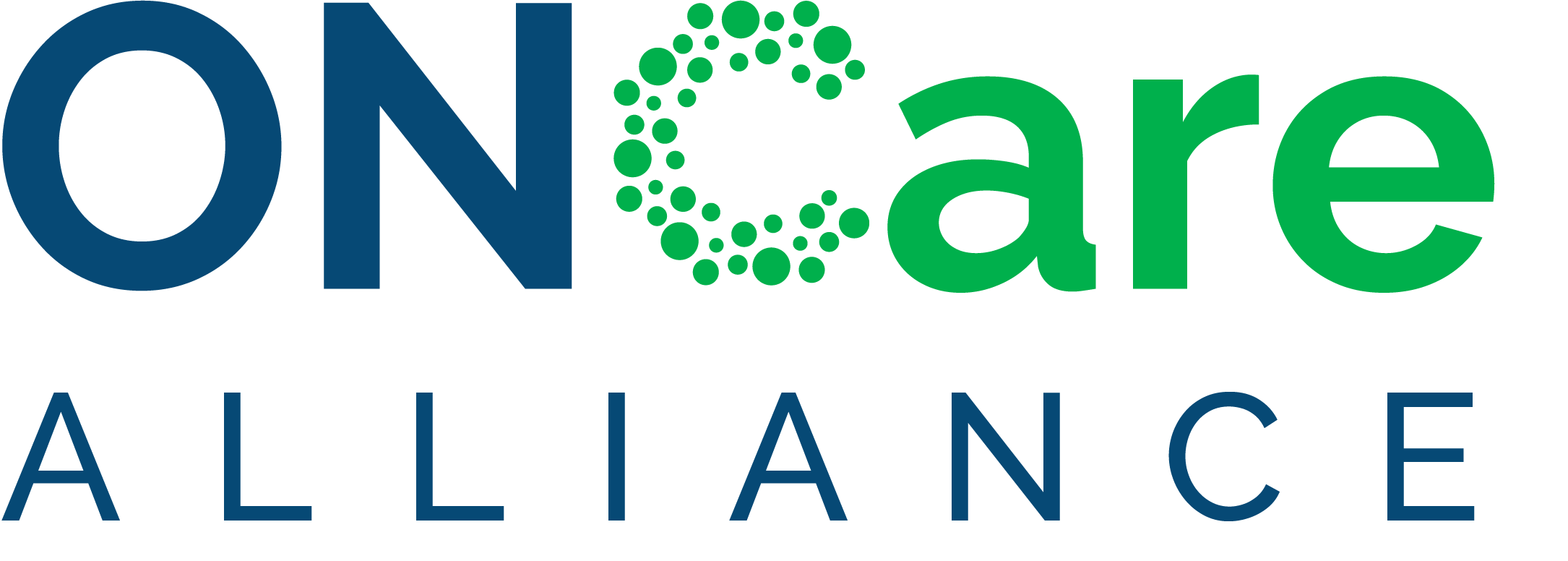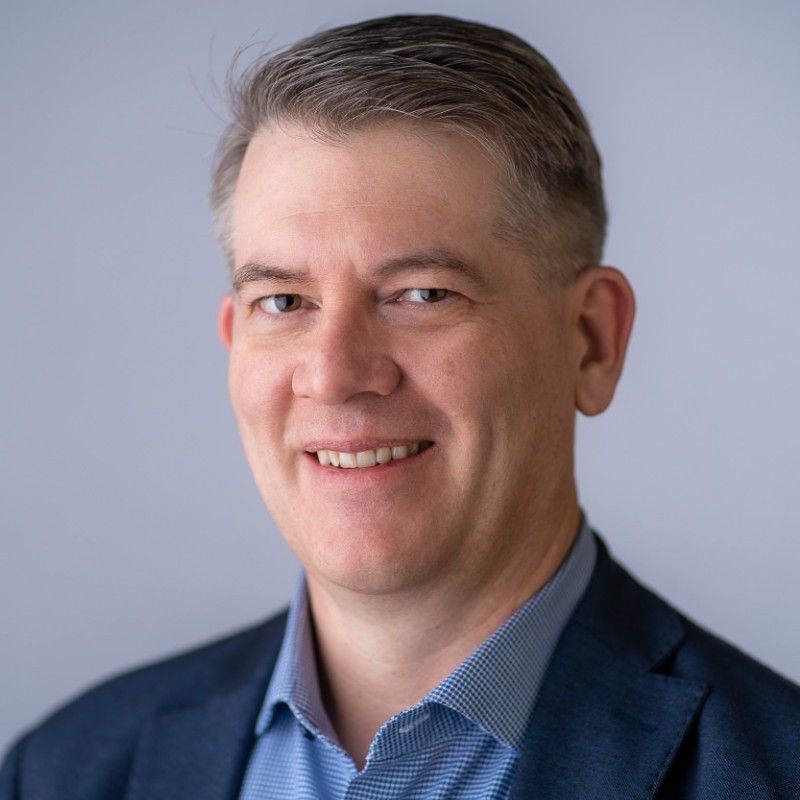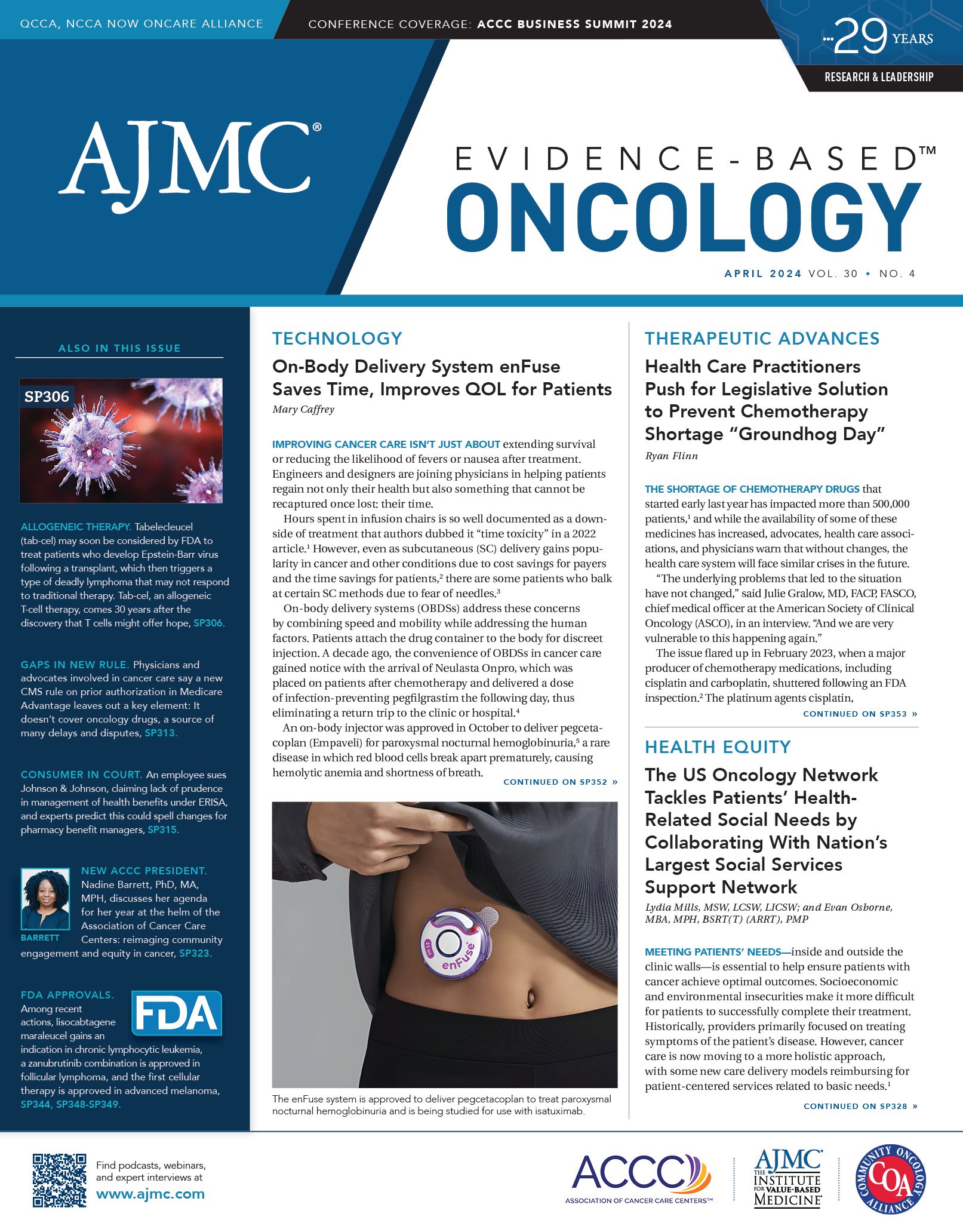- Center on Health Equity and Access
- Clinical
- Health Care Cost
- Health Care Delivery
- Insurance
- Policy
- Technology
- Value-Based Care
From Our Partners: April 2024
News from Strategic Alliance Partners of The American Journal of Managed Care.
COA Asks CMS to Resolve Express Scripts’ “Underwater” Payments Following End of DIR Fees
On February 22, 2024, the Community Oncology Alliance (COA), which represents independent cancer care practices, asked CMS to act following a dramatic drop in reimbursements from Express Scripts, Inc (ESI), effective January 1, 2024.1 This opens a new chapter in the COA’s ongoing effort to ensure fair compensation when members prescribe high-cost cancer drugs.
COA logo | Image credit: COA

Under a new rule adopted last year, CMS now prohibits Medicare Part D plan sponsors and pharmacy benefit managers (PBMs) from retroactively assessing direct and indirect remuneration (DIR) fees, which were often charges based on quality metrics designed for primary care practices that oncology practices could never meet.2
Many oncology practices operate their own in-house pharmacy so they can adjust patients’ regimens on the spot after seeing a patient and reviewing tests. These DIR fees were assessed in oncology practices months after the claim had been submitted and paid under Part D.
Oncologists anticipated that shutting off the DIR revenue stream would invite pushback from health plans and PBMs. However, during a webinar held ahead of the announcement, COA leaders and Pontchartrain Cancer Center CEO Kathy Oubre, MS, said reimbursement cuts are worse than anticipated. Cuts vary from drug to drug and from plan to plan—and Oubre even found differences across plans within a given payer.
However, ESI’s 2024 contract is offering reimbursement rates in which the payment to the oncology practice is less than the cost of acquiring the drug. Thus, if a practice opts to write the prescription for the convenience of the patient, it does so at a loss. During the webinar, leaders said that the COA learned from provider associations in other specialties and groups that represent independent pharmacies that this change appears to be widespread.
The COA sent letters to ESI and to CMS “expressing serious concerns about underwater reimbursement to independent community oncology practices, as well as for other specialty and retail pharmacy providers,” the group said in a statement. The statement said that ESI’s contract “is reimbursing pharmacy providers below the cost of doing business, endangering their ability to provide care and medication for patients with cancer and other serious diseases.”
In its letter to CMS, the COA took specific issue with the indefinite reimbursement terms at point-of-sale. “ESI’s contract guarantees providers reimbursements only ‘up to an average discount’ off average wholesale price [AWP; up to an average of AWP minus 24%].”
COA stated in its letter that this language means “there is no clear, consistent reimbursement rate for each drug.” In fact, 2 different providers could receive different reimbursements on the same day at far different rates.There is no specificity of payment, despite a requirement in Missouri law, the letter states. Oncology practices are left with no way to predict what reimbursements will be. The COA is calling on CMS to step in and exercise its regulatory authority to demand ESI provide rates that are “reasonable and relevant.”1
Similarly, the COA’s letter to ESI President Adam Kautzner, PharmD, asked that the pharmacy giant immediately amend its 2024 Pharmacy Provider Agreement contract terms to ensure that reimbursement is reasonable, relevant, definitive, and in full compliance with applicable state and federal laws, including Medicare Part D.
In its statement, the COA said ESI is motivated by profit—pure and simple. Its practices risk further undermining independent pharmacies that serve rural or underserved communities and creating more “pharmacy deserts.”
“This brazen attempt to squeeze cancer care providers and pharmacists will only hurt patients. When practices close their doors because they cannot afford to do business, patients are forced to travel farther and pay more for lifesaving drugs. It is a sad state of affairs when patient health is secondary to better PBM profit margins,” said Ted Okon, MBA, executive director of COA.
“COA hopes that ESI is willing to work together to resolve this issue but is working to educate Congress and is prepared to pursue legal remedies, if necessary,” the group said in its statement.
References
1. Community Oncology Alliance calls on Express Scripts to fix underwater reimbursement to oncology pharmacy providers. News release. Community Oncology Alliance. February 22, 2024. Accessed March 13, 2024. https://mycoa.communityoncology.org/news-updates/press-releases/community-oncology-alliance-calls-on-express-scripts-to-fix-underwater-reimbursement-to-oncology-pharmacy-providers
2. CMS eliminates retroactive DIR fees. American Pharmacists Association. Accessed March 10, 2024. https://www.pharmacist.com/Advocacy/Issues/CMS-Eliminates-Retroactive-DIR-Fees
QCCA, NCCA Merge to Form ONCare Among Independent Oncology Practices
Competition in community oncology took another turn February 29, 2024, with the merger of 2 entities: the National Cancer Care Alliance (NCCA) and the Quality Cancer Care Alliance (QCCA).
ONCare logo | Image credit: ONCare Alliance

The new organization, called ONCare Alliance, will be led by 2 of the leading women in community oncology: cochairs Barbara McAneny, MD, CEO of the New Mexico Cancer Center and founder of the NCCA; and Sibel Blau, MD, of Northwest Medical Specialties, PLLC, in Puyallup, Washington, and CEO of the QCCA.
In a statement, leaders said the new entity would combine the QCCA’s focus on clinical research, growth, and strategy with the NCCA’s strengths in advocacy, patient assistance, education, and resource initiatives.
The union of the 2 smaller independent practice groups comes as 2 other community oncology organizations, OneOncology and The US Oncology Network, continue to add practices to thrive in an increasingly competitive marketplace amid challenges such as drug shortages and new regulatory requirements.
ONCare will be based in Washington state. Blau will serve as president and CEO, whereas McAneny will be the group’s chief officer of advocacy and government affairs. McAneny is a former president of the American Medical Association.
According to their respective websites, the 2 groups represent a combined 33 independent practices.
“This merger represents a pivotal moment in the advancement of independent, comprehensive, patient-centric cancer care. Independent practices have always been the foundation for care for underserved populations,” McAneny said in the statement. “By working as an alliance, we can enhance the ability of practices to better serve their communities, competing successfully with corporate delivery systems while maintaining both patient and physician satisfaction.”
Blau added that their mission is “to sustain and enhance independent practices by providing opportunities for collaboration in research, data-based projects, patient support services, and practice enhancement strategies.”
Reference
Powerhouses QCCA and NCCA merge to create a transformative new entity in independent practice oncology and cancer care: ONCare Alliance, LLC. News release. Pharmiweb. February 29, 2024. Accessed February 29, 2024. https://www.pharmiweb.com/press-release/2024-02-29/powerhouses-qcca-and-ncca-merge-to-create-a-transformative-new-entity-in-independent-practice-oncolo
SPOTLIGHT: Cancer Care Plans Within ACOs Must Center Patients First, Says Leslie Busby, MD
Leslie Busby, MD, board-certified medical oncologist and hematologist at Rocky Mountain Cancer Centers and chairman of The US Oncology Network Pharmacy & Therapeutics Committee, discusses with Evidence-Based Oncology (EBO) the process of developing patient-centered care plans within the framework of an accountable care organization (ACO) and the importance of staying up-to date with the latest best practices and therapies.
EBO: Can you describe the process of developing patient-centered cancer care plans within the ACO framework?
Leslie Busby, MD | Image credit: The US Oncology Network

Busby: Whatever plan you have, you definitely have to put the patient at the center of anything. So when we’re talking about choosing regimens that might be best, we start off by which regimens are most active and which have the best data to support their use, and then we also look into the toxicity. So any sort of program or anything that we’re looking at, the first step is, how will this affect the patient? Patients don’t want to go in the hospital, so if we look at, “OK, how do we keep patients out of the hospital?” then we go from there. It’s always the clinical aspect first, before you walk into any sort of decision or strategy behind it.
EBO: What measures are in place to help ensure that patients receive the most up-to-date, evidence-based cancer treatments and therapies while still controlling costs?
Busby: We rely a lot on the US Oncology pathways. The pathways task force is a subcommittee of the [Pharmacy & Therapeutics] Committee, and we have several members of Rocky Mountain Cancer Centers as part of that committee or as part of disease specialist advisors to that committee. They meet monthly, always overlooking the pathways—do they need to be updated—and also staying ahead of new information coming out, whether from a major meeting such as ASCO [American Society of Clinical Oncology] and ASH [American Society of Hematology] or just new papers that are coming out. We also have a system set up that any regimen that goes on our pathway must be an NCCN [National Comprehensive Cancer Network]–based regimen first.
While NCCN has a little bit of a different way of looking at things, they’re sort of taking the totality, the whole universe of regimens out there, and paring them down to those that really have decent support. And then we’re paring it down a little bit further, which fits our our strategy of “good product, controls toxicity, and is lower cost.” I think you have to meet often. There are groups out there that have pathways, and they fall behind really fast, and it makes it a challenge to perform on their pathways when they’re not keeping up to date.
EBO: Are there any oncology quality measures in particular that have been challenging to improve upon in an ACO?
Busby: I think what I struggle with, and looking at the numbers, [they] are around advanced care planning and hospice care. When I when I look at, I think there’s 2 issues that we have struggled to get by—all of us. One is as oncologists, we go in with the mindset of wanting to treat
patients, wanting to try to control their cancer. So it is a little bit different. You have to think a little bit differently when it comes to advanced care planning and hospice. The other side is that there’s a lot of patients who just aren’t ready for it. We need to find that sweet spot in the middle where we can still bring it up and talk to the patients without them shutting down, but we at least start opening the door. And still looking for that best approach—even though I’ve been practicing over 20 years—in my own day-to-day approach, and what works best for each patient. But that is a metric that I feel like we’ve improved, but not as much as I’d hoped.
EBO: What challenges or barriers impact the delivery of high-quality cancer care in an ACO, and how have these challenges been addressed?
Busby: One challenge is that there’s information about new drugs that are out faster than sometimes the data to support their use is out there. So patients ask about it, even the doctors ask about it. But when you look at the study that’s out there, it’s not clear if it’s helpful or not. Maybe it is.
I blame a little bit of the FDA’s accelerated approval process. It’s allowed the manufacturers to get their drug approved, so it is out there faster—but it’s often out there before all the data has matured. The other problem with that is they still want to charge quite a bit for these new drugs.
The other aspect about these programs is there’s data that sometimes we’re held to, but we don’t always have the information on a real-time basis—for example, hospitalization. A commercial payer actually knows pretty fast when someone went to the [emergency department] and went to the hospital because that card is swiped at the [emergency department] or at the hospital. But we may not know unless the patient tells us or later on, especially if it was unrelated to us, that the payer comes back and says, “Yeah, this person was admitted.” And that’s been a struggle to get that more in real-time. The problem with that is if we come up with an idea to try to lower the rates, it’s hard to tell how well we’re doing because the information coming back to us is so delayed, we’ve almost forgotten what we did. “Oh, yes, we implemented that 12 or 18 months ago, and maybe we’re starting to see a benefit, or we didn’t really see a benefit. Let’s start again and see if we can find something better.”

Virtual Reality and Biofeedback Training Appear Effective for DMD, BMD Rehabilitation
April 29th 2024A recent study suggests virtual reality and biofeedback training may be feasible and effective for patients with Duchenne muscular dystrophy (DMD) and Becker muscular dystrophy (BMD).
Read More
Navigating Health Policy in an Election Year: Insights From Dr Dennis Scanlon
April 2nd 2024On this episode of Managed Care Cast, we're talking with Dennis Scanlon, PhD, the editor in chief of The American Journal of Accountable Care®, about prior authorization, price transparency, the impact of health policy on the upcoming election, and more.
Listen
CMS' 340B Repayment Proposal May Harm Vulnerable Hospitals, Reward Those With Higher Revenues
April 26th 2024The 340B hospitals not receiving an offsetting lump-sum payment from CMS following 2018-2022 cuts later ruled unlawful are disproportionately rural, publicly owned, and nonacademic, according to a new study.
Read More
Dr Kathy Zackowski Discusses the Importance of Rehabilitation Research and Trials in MS
April 26th 2024Kathy Zackowski, PhD, National MS Society, expresses the inherent value of quality rehabilitation trials for broadening clinical understandings of multiple sclerosis (MS) and bettering patient outcomes.
Read More
